Summary Overview
Landscaping Services Market Overview
The global landscaping services market is expanding steadily, fuelled by rising demand in sectors such as residential, commercial, hotel, and municipal landscaping. This industry provides a diverse variety of services, such as lawn care, garden design, irrigation systems, tree pruning, and hardscaping solutions. Our paper analyses procurement trends in depth, with an emphasis on cost-cutting initiatives and the implementation of sustainable practices to improve service delivery and operational efficiency.Future landscaping services procurement problems include managing labour costs, assuring scalability, preserving environmental sustainability, and integrating novel technology with established service models. Digital technologies and strategic sourcing are essential for streamlining landscaping service delivery, assuring high-quality outcomes, and retaining long-term competitiveness. As global demand grows, corporations are using market intelligence to improve operational efficiency, reduce costs, and mitigate potential risks
Market Size: The global Landscaping Services market is projected to reach USD 635.04 billion by 2035, growing at a CAGR of approximately 6.45% from 2025 to 2035.
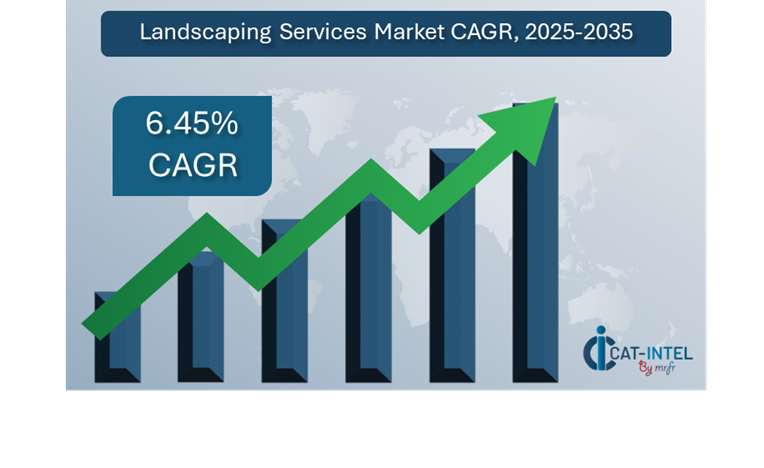
Growth Rate: 6.45%
Sector Contributions: Growth in the market is driven by:
Operational Efficiency and Process Integration: Real-time data and process integration are becoming increasingly important for optimizing landscaping service operations, from planning to execution.
Residential and Commercial Growth: To address rising demand, landscaping businesses are using innovative equipment for effective grass care, garden upkeep, and outside design.
Technological Advancements: Artificial intelligence and automation tools are redefining landscaping services by providing predictive maintenance and smart irrigation systems.
Service Innovation: Modular service offers allow clients to choose specialized landscaping solutions, such as seasonal maintenance, garden redesigns, and more personalized solutions.
Investment in Sustainability: Businesses are increasingly investing in environmentally friendly landscaping methods such as sustainable lawn care, water conservation systems, and trash management.
Regional Insights: North America and Asia Pacific continue to be significant markets for landscaping services, owing to increasing disposable income and desire for upmarket residential and commercial premises.
Key Trends and Sustainability Outlook
Sustainability Integration: There is a rising trend of incorporating sustainable techniques into landscaping services, such as drought-tolerant plants and environmentally friendly pest treatment.
Smart Landscaping Systems: The proliferation of smart landscaping technology such as IoT sensors for irrigation and smart lighting systems is improving service offerings and enabling better resource management.
Customization and Personalization: From personal gardens to corporate landscapes, organizations modify their solutions to meet the specific needs of each market group.
Data-Driven Insights: Advanced data analytics are being utilized to analyse grass health, water consumption, and environmental conditions, giving landscaping firms vital information.
Growth Drivers:
Digital Transformation: Landscaping firms are implementing digital solutions to improve operational efficiency, such as mobile applications for service requests and automated project management.
Demand for Automated Services: Automation in landscaping is becoming increasingly popular, including robotic lawn mowers, automatic irrigation systems, and AI-powered plant health monitoring.
Scalability and Flexibility: Companies are investing in scalable solutions that can expand to meet their demands, whether by adding additional service areas or boosting labour capacity.
Regulatory Compliance: Landscaping companies are implementing innovative technology to assure compliance with local environmental requirements, such as water consumption limitations and pesticide management.
Globalization: Urbanization are driving up demand for sustainable, high-quality landscaping services that can meet the demands of both private homes and commercial metropolitan spaces.
Overview of Market Intelligence Services for the Landscaping Services Market
Recent research has identified important constraints in the landscaping services industry, including high operating costs and the requirement for service customisation to fulfill various customer preferences. Market intelligence studies provide meaningful insights into procurement prospects, enabling landscaping businesses to find cost-cutting initiatives, optimise supplier relationships, and improve service performance. These insights enable businesses to comply with industry laws and maintain high-quality standards while successfully controlling expenses.
Procurement Intelligence for Landscaping Services: Category Management and Strategic Sourcing
To remain competitive in the landscaping services industry, businesses are optimizing procurement procedures by reviewing service prices and monitoring vendor performance. Effective category management and strategic sourcing are critical for lowering procurement costs while maintaining a steady supply of high-quality items and services. By employing meaningful market knowledge, landscaping firms may enhance their buying methods, negotiate attractive arrangements with suppliers and choose providers who meet sustainability and quality criteria. This technique ensures that landscaping firms can exceed customers' expectations while remaining profitable.
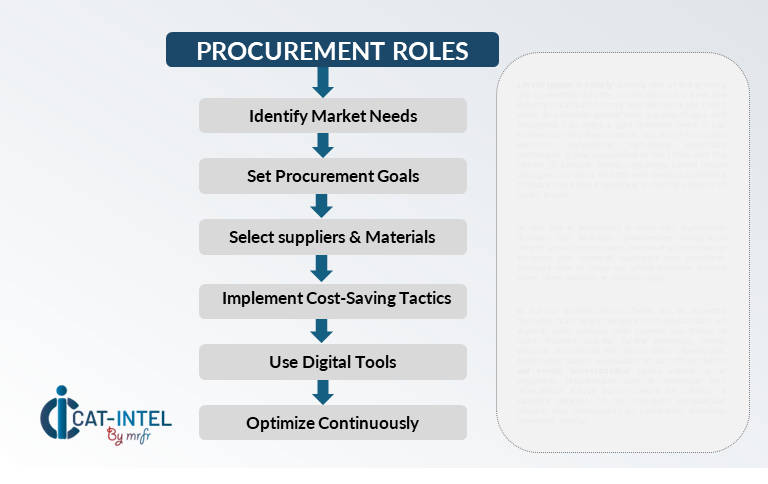
Pricing Outlook for Landscaping Services: Spend Analysis
The pricing prognosis for landscaping services is likely to be somewhat dynamic, with swings caused by a variety of variables. Technological developments, rising demand for environmentally friendly solutions, seasonal fluctuations, and regional pricing variances are all important drivers.
Graph shows general upward trend pricing for Landscaping Services and growing demand. However, there may be fluctuations influenced by economic conditions, technological advancements, and competitive dynamic.
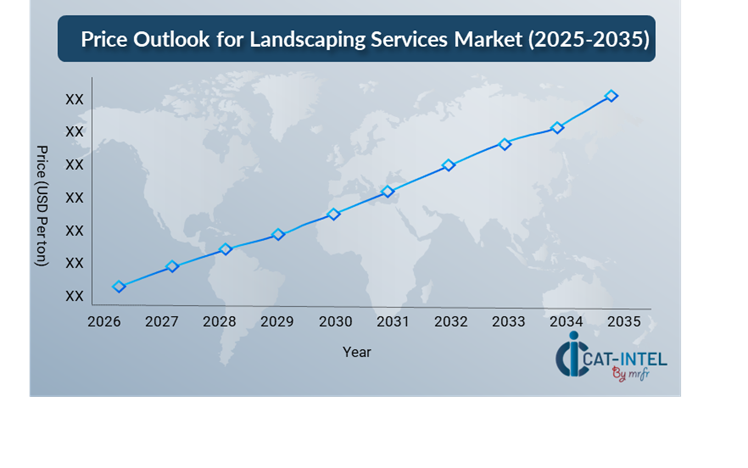
Efforts to streamline procurement procedures, strengthen vendor relationships, and implement modular service offerings are critical for lowering landscaping service costs. Leveraging digital technologies for market monitoring, service pricing forecasts, and effective contract administration can help to reduce costs even further.
Partnering with reputable vendors, negotiating long-term contracts, and investigating subscription-based or bundled service models are all excellent ways to minimize landscaping expenditures. Despite these hurdles, prioritizing scalability, guaranteeing efficient service delivery, and using smart technologies such as IoT-powered irrigation systems will be vital to sustaining cost-effectiveness and operational excellence.
Cost Breakdown for Landscaping Services: Total Cost of Ownership (TCO) and Cost-Saving Opportunities
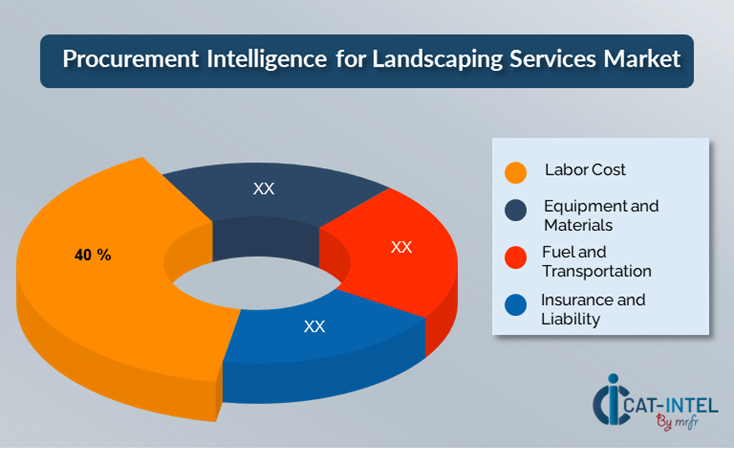
Labor Costs: (40%)
Description: Labor expenditures account for most of the total cost of landscaping services. This comprises the pay for landscape specialists (e.g., gardeners, arborists, technicians), supervisors, and seasonal labour
Trend: There is an increasing use of technology and automation to minimize human labour expenditures, such as robotic lawnmowers or drone-assisted monitoring.
Equipment and Materials: (XX%)
Fuel and Transportation: (XX%)
Insurance and Liability: (XX%)
Cost-Saving Opportunities: Negotiation Levers and Purchasing Negotiation Strategies
In the landscaping services business, streamlining procurement procedures and using strategic negotiating strategies may result in significant cost savings and increased operational efficiency. Long-term collaborations with major suppliers, particularly those who provide sustainable products and eco-friendly solutions, can result in more attractive price structures, such as bulk discounts and bundled service packages. Subscription-based service models and multi-year vendor agreements can provide possibilities to lock in reduced rates and hedge against price volatility over time.
Collaborating with suppliers and service providers who value innovation and sustainability offers additional benefits. This provides access to innovative technology such as smart irrigation systems, eco-friendly landscaping equipment and integrated landscape management platforms can assist save long-term operating expenses. Landscape firms may improve transparency, reduce waste, and optimize service delivery by implementing digital procurement technologies like as contract management software and service usage analytics.

Supply and Demand Overview for Landscaping Services: Demand-Supply Dynamics and Buyer Intelligence for Effective Supplier Relationship Management (SRM)
The landscaping services market is expanding steadily, driven by rising demand for beautiful and sustainable outdoor solutions in the residential, commercial, and public sectors. Technological improvements, industry-specific customisation requirements, and changing environmental restrictions all have an impact on supply and demand dynamics.
Demand Factors:
Sustainability & Green Initiatives: The increased emphasis on sustainable landscaping, such as drought-tolerant plants and eco-friendly irrigation systems, is increasing demand for ecologically aware landscaping services.
Technological Integration: A movement toward smart landscaping technology like autonomous lawn mowers and AI-driven landscape management is growing demand for high-tech, efficient service solution.
Customization for Specific Industries: Different industries, such as hospitality, retail, and residential, have distinct landscaping requirements. For example, premium hotels may necessitate complex landscape designs.
Health and Wellness Trends: As people become more aware of the health and wellness advantages of green areas, such as increased air quality and aesthetic appeal, there is a growing demand for high-quality landscaping services.
Supply Factors:
Technological Advancements: In landscaping, such as automated irrigation systems, drones for large-area inspections, and smart garden equipment, are improving service offerings.
Supplier Ecosystem: A rising supply base, ranging from small local landscapers to big national service providers, guarantees a diverse range of alternatives for both companies and consumers.
Economic Factors: Labor costs, material prices, and area demand changes all have an impact on landscaping service pricing and availability.
Scalability and Customization: Landscaping service providers are increasingly providing modular solutions to organizations of all sizes, guaranteeing flexibility and scalability in service delivery.
Regional Demand-Supply Outlook: Landscaping Services
The Image shows growing demand for Landscaping Services in both North America and Asia Pacific, with potential price increases and increased Competition.
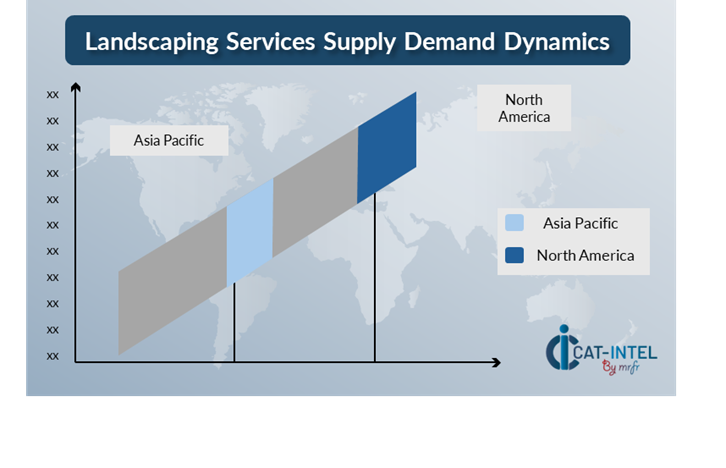
North America: Dominance in the Landscaping Services Market
North America, particularly the United States, is a dominant force in the global Landscaping Services market due to several key factors:
Access to Capital and Investment: North America has a developed financial market with easy access to capital. This enables businesses to invest in new technology, expand operations, and seek ongoing innovation.
High Consumer and Business Demand: The North American market is characterized by strong demand for both residential and business services, which is driving market growth.
Established Industry Leaders: North America is home to some of the largest and most important corporations in different industries, including landscaping services, which contributes to the region's dominant market position.
Strong Economic Landscape: North America, notably the United States and Canada, has a well-developed economy with significant investment in both residential and commercial sectors.
Technological Advancement and Innovation: North America is a hotbed of technical innovation. Smart technologies are commonly used in businesses such as landscaping services.
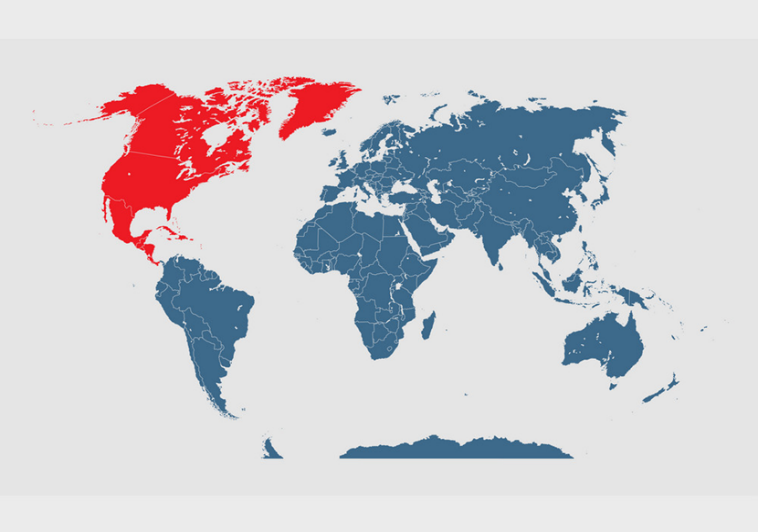
North America Remains a key hub Landscaping Services Price Drivers Innovation and Growth.
Supplier Landscape: Supplier Negotiations and Strategies
The supplier environment in the landscaping services market is diversified and competitive, with a mix of large-scale national service providers and smaller, specialized businesses defining industry dynamics. These providers have a significant impact on service cost, customisation, and delivery quality. The industry is generally controlled by well-established landscaping companies that provide full outdoor maintenance and design services, while smaller, niche competitors focus on certain market niches or unique offers such as sustainable landscaping, smart garden technology, or specialist lawn care.
The Landscaping Supplier Ecosystem Across Key Regions comprises both well-known national suppliers and creative local companies that cater to unique client demands. As property owners and businesses place a greater emphasis on environmental sustainability, aesthetic appeal, and smart technology integration, landscaping service providers are adapting by incorporating eco-friendly practices, integrating cutting-edge technologies, and providing flexible service models to meet changing client demands.
Key Suppliers in the Landscaping Services Market Include:
BrightView
TruGreen
Davey Tree Expert Co.
US Lawns
Gothic Landscape
SaveATree
Lawn Doctor
Greenworks Commercial
The Brickman Group
Barton and Sons Landscaping

Key Developments Procurement Category Significant Development
Significant Development |
Description |
Market Growth |
The landscaping services industry is expanding rapidly as demand for high-quality, environmentally friendly outdoor solutions rises across the residential, business, and public sectors. |
Cloud Adoption |
There is a growing trend toward sustainable landscaping approaches, fueled by rising environmental consciousness and demand for eco-friendly solutions including water-efficient irrigation, native plants, and green waste management. |
Product Innovation |
Landscaping firms are increasing their service offerings by combining smart technology such as IoT-powered irrigation systems, automated lawn care, and smart outdoor lighting, which enable more efficient and sustainable landscapes. |
Technological Advancements |
Drones for large-area surveys, robotic lawn mowers, and AI-driven landscape design are improving landscaping services by giving more precise, cost-effective, and efficient solutions to clients.
|
Global Trade Dynamics |
Environmental laws and sustainability requirements are affecting the landscaping services industry, particularly for commercial and municipal projects that must adhere to local legislation governing water consumption, chemical applications, and green space management. |
Customization Trends |
Customers are increasingly looking for individualized landscaping services, including bespoke designs, seasonal upkeep, and specialty features like green roofs or sustainable gardens, to fulfill specific demands and environmental goals. |
Landscaping Services Attribute/Metric |
Details |
Market Sizing |
The global Landscaping Services market is projected to reach USD 635.04 billion by 2035, growing at a CAGR of approximately 6.45% from 2025 to 2035. |
Landscaping Services Technology Adoption Rate |
Approximately 45% of landscaping organizations worldwide have used technological solutions, with a growing emphasis on smart landscaping technologies such as IoT-based irrigation systems and automated lawn care solutions. |
Top Landscaping Services Industry Strategies for 2025 |
Key tactics include combining sustainable landscaping methods, integrating smart technology for effective outdoor management, improving service personalization, and focusing on customer experience via digital tools such as mobile applications for service requests. |
Landscaping Services Process Automation |
Approximately 40% of landscaping service companies are automating basic operations like grass care, irrigation management, and scheduling to increase operational efficiency and save labor costs. |
Landscaping Services Process Challenges |
Major obstacles include high labor costs, seasonal demand variations, maintaining client expectations, and guaranteeing the long-term viability of landscaping materials and procedures.
|
Key Suppliers |
Leading landscaping service providers include BrightView, The Davey Tree Expert Company, and TruGreen, which provide full landscaping services ranging from lawn care to design and maintenance. |
Key Regions Covered |
North America, Europe, and Asia-Pacific are popular destinations for landscaping services, with strong demand from metropolitan areas, business spaces, and residential properties. |
Market Drivers and Trends |
Growth is being driven by rising demand for sustainable landscaping, increased acceptance of smart technologies (such as IoT and AI), an emphasis on urban green spaces, and customer preference for personalized, eco-friendly outdoor solutions. |

